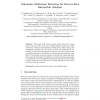Free Online Productivity Tools
i2Speak
i2Symbol
i2OCR
iTex2Img
iWeb2Print
iWeb2Shot
i2Type
iPdf2Split
iPdf2Merge
i2Bopomofo
i2Arabic
i2Style
i2Image
i2PDF
iLatex2Rtf
Sci2ools
COST
2008
Springer
2008
Springer
Automatic Motherese Detection for Face-to-Face Interaction Analysis
This paper deals with emotional speech detection in home movies. In this study, we focus on infant-directed speech also called "motherese" which is characterized by higher pitch, slower tempo, and exaggerated intonation. In this work, we show the robustness of approaches to automatic discrimination between infant-directed speech and normal directed speech. Specifically, we estimate the generalization capability of two feature extraction schemes extracted from supra-segmental and segmental information. In addition, two machine learning approaches are considered: k-nearest neighbors (k-NN) and Gaussian mixture models (GMM). Evaluations are carried out on real-life databases: home movies of the first year of an infant.
Related Content
| Added | 18 Oct 2010 |
| Updated | 18 Oct 2010 |
| Type | Conference |
| Year | 2008 |
| Where | COST |
| Authors | Ammar Mahdhaoui, Mohamed Chetouani, Cong Zong, Raquel Sofia Cassel, Catherine Saint-Georges, Marie-Christine Laznik, Sandra Maestro, Fabio Apicella, Filippo Muratori, David Cohen |
Comments (0)

